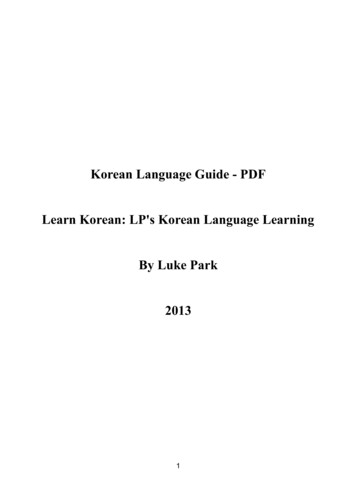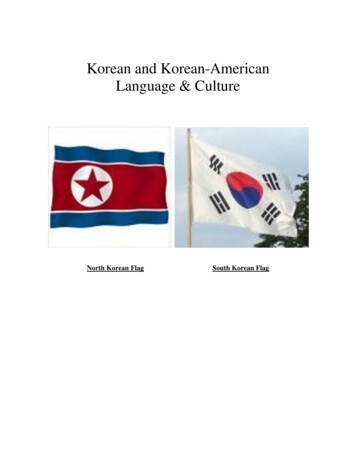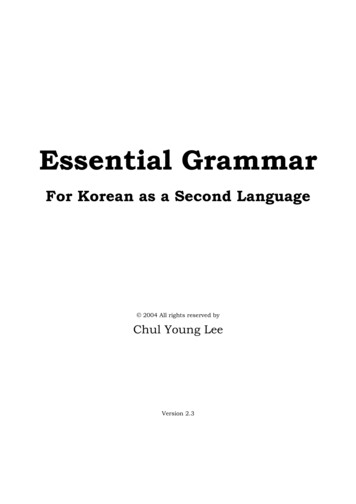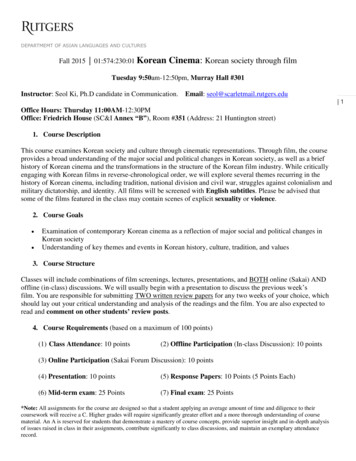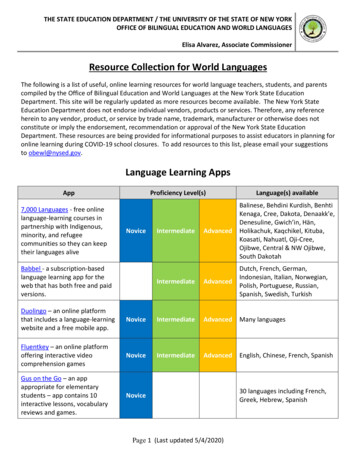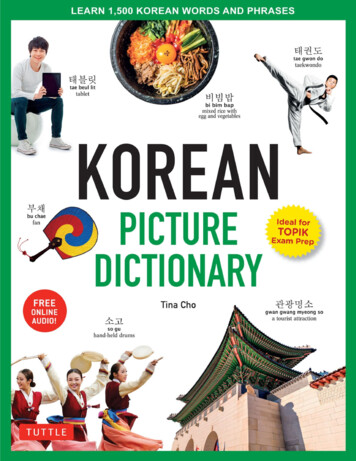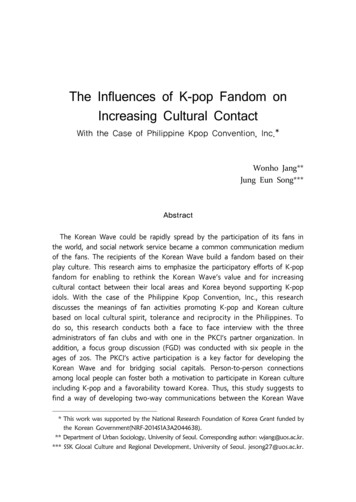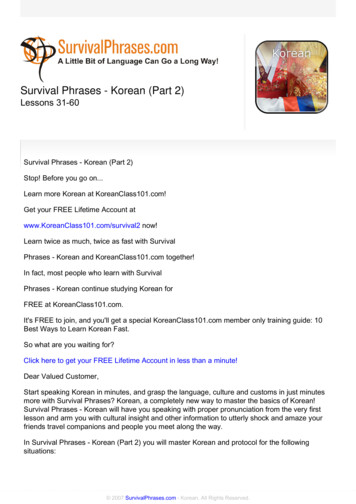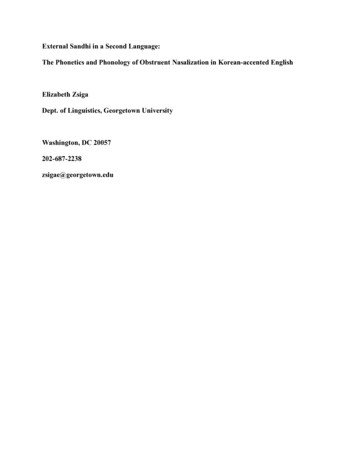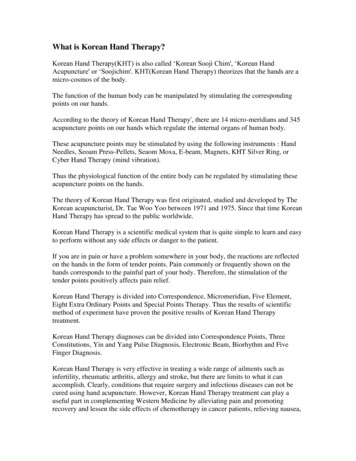
Transcription
What is Korean Hand Therapy?Korean Hand Therapy(KHT) is also called ‘Korean Sooji Chim', ‘Korean HandAcupuncture' or ‘Soojichim'. KHT(Korean Hand Therapy) theorizes that the hands are amicro-cosmos of the body.The function of the human body can be manipulated by stimulating the correspondingpoints on our hands.According to the theory of Korean Hand Therapy', there are 14 micro-meridians and 345acupuncture points on our hands which regulate the internal organs of human body.These acupuncture points may be stimulated by using the following instruments : HandNeedles, Seoam Press-Pellets, Seaom Moxa, E-beam, Magnets, KHT Silver Ring, orCyber Hand Therapy (mind vibration).Thus the physiological function of the entire body can be regulated by stimulating theseacupuncture points on the hands.The theory of Korean Hand Therapy was first originated, studied and developed by TheKorean acupuncturist, Dr. Tae Woo Yoo between 1971 and 1975. Since that time KoreanHand Therapy has spread to the public worldwide.Korean Hand Therapy is a scientific medical system that is quite simple to learn and easyto perform without any side effects or danger to the patient.If you are in pain or have a problem somewhere in your body, the reactions are reflectedon the hands in the form of tender points. Pain commonly or frequently shown on thehands corresponds to the painful part of your body. Therefore, the stimulation of thetender points positively affects pain relief.Korean Hand Therapy is divided into Correspondence, Micromeridian, Five Element,Eight Extra Ordinary Points and Special Points Therapy. Thus the results of scientificmethod of experiment have proven the positive results of Korean Hand Therapytreatment.Korean Hand Therapy diagnoses can be divided into Correspondence Points, ThreeConstitutions, Yin and Yang Pulse Diagnosis, Electronic Beam, Biorhythm and FiveFinger Diagnosis.Korean Hand Therapy is very effective in treating a wide range of ailments such asinfertility, rheumatic arthritis, allergy and stroke, but there are limits to what it canaccomplish. Clearly, conditions that require surgery and infectious diseases can not becured using hand acupuncture. However, Korean Hand Therapy treatment can play auseful part in complementing Western Medicine by alleviating pain and promotingrecovery and lessen the side effects of chemotherapy in cancer patients, relieving nausea,
so that the patients can continue to receive the treatment.Korean Hand Therapy contributes to the maintenance of a persons health as well as selfdiagnosis. It is possible to perform self treatment, treat family members and even employKHT as a volunteer activity for charity.The research of KHT has been actively spread since Korean Hand Therapy Institute andYin Yang Maek Jin Publishing Co.Ltd. was established in 1977. Nowadays, there are 170domestic branches and 27 overseas branches established all over the world.The members are estimated to be about three million. In addition, volunteer memberswho practice KHT for charity are estimated to be about 200 groups.· Development of Korean Hand TherapyPrior to discovering Korean Hand Therapy, traditional acupuncture that utilizes the wholebody for treatment, was the subject of Dr. Yoo's research and practice. However, in hispractice of traditional acupuncture, he noticed some disadvantages or shortcomings inbody acupuncture needles. The needles were thick and long; thus the insertion was deepand painful. These thick and long needles may cause serious side effects such asdeafness, paralysis, and unconsciousness as well as aggravation of disease.Furthermore, Dr. Yoo sometimes observed that the ailments were not healed well whentreatment was performed according to meridian theories of traditional body acupuncture.As he studied body acupuncture more deeply, he took a skeptical and negative view ofmeridian theories in Traditional Body Acupuncture since the presence of the meridiancould not be proven in a scientific experiment.In addition, it was difficult for lay people to understand traditional body acupuncturesince the theories were too abstract and ideological.Therefore, Dr. Yoo started to study a new concept of acupuncture that is quite simple tolearn and safe to perform without any side effect.His interest in physiognomy urged him to study the relationship of the face and bodymore profoundly and he came to realize that the face is interrelated to the diseased part ofthe body. In other words, the entire body is represented on the face. The condition of thebody as well as the destiny can be foreseen by looking over the face. For instance, if youhave a clean and smooth forehead without any wrinkle, it means that the body is healthyand the function of the stomach is good, however, if you have many wrinkles and a roughforehead, it indicates that the body has constant slight ailments, especially some problemsrelated to the function of the stomach.Finally, Dr. Yoo got a hint that the entire body is represented on the hands as the entirebody is on the face.
In addition, Dr. Yoo also studied the theory of the visceral-somatic reflex that is based onthe following hypothesis ; reaction and changes occur on their corresponding orinterconnected organs, tissues, muscles and skin through the nervous system when certainviscera are infected and / or disordered.For example, when there is any abnormal change in the viscera, the nerve impulse istransferred to the central nervous system by the afferent nerve fibers of the autonomicnerves. Once it reaches the brain, the brain commands the affected body parts through theefferent nerve fibers. The mechanism of correspondence in Korean Hand Acupuncture isvery similar to the mechanism of the visceral-somatic reflex.The stimulation of the corresponding points of certain body parts initiates the hand toorgan reflex first then the organ to organ reflex. Then it develops into the visceral tosomatic reflex. It also states that a large number of different human diseases can betreated or cured through the route of the reflex system, and this theory has been verifiedby clinical experiments such as thermograms.The stimulation of the hand is very effective due to the presence of a large number ofsympathetic nerve fibers in the hands.· Present position of Korean Hand TherapyThe science of acupuncture, moxibustion, and herbal medicine are important componentof traditional oriental medicine that were developed in the East about 2500 years ago.Oriental Medicine that originated in China is called Traditional Chinese Medicine,oriental medicine from Japan is called Japanese Oriental Medicine, and that from Koreais called Traditional Korean Medicine or Korean Oriental Medicine.However, Korean Hand Therapy, a form of alternative medicine, differs from bothKorean Traditional Medicine and Western medicine. It was not popular word among thepeople until the word of 'SOOJI CHIM' appeared to the Korean dictionary by Mr. HeeSung Lee in 1980.KHT has been practiced by many people as well as licensed doctors after a decision ofthe supreme court on April 17, 1994 stating that it is not illegal that the general publicinsert the needles to others if it is performed without pay, even though they are notpractitioners. As a result, KHT volunteer members can perform KHT for charity.Thousands of people treat friends and strangers. Some accomplished practitioners haveailing patients actually lined up outside their doors.· Popularization of Korean Hand TherapyKorean Hand Therapy has rapidly spread all over the world since KHT was revealed tothe public. In Japan , Many clinical KHT experiments were performed by the late Dr.
Manaka Yoshio, Dr. Yastu Mistuo, the honorary professor of Nihon University , Dr. HidaKazhiko, the otholaryngologist, since Korean Hand Therapy information was seriallypublished in a Japanese journal of western medicine by Dr. Tae Suk Song in 1977. In theUS , KHT was introduced first to the 2nd International Oriental Medicine Congress heldin 1984. Since then, KHT seminars have been held periodically.Both Dr. Peter Eckman and Dr. Jae Woo Yoo have put in a great deal of effort to spreadKHT in the US . Since 1994 Dr. Dan Lobash has worked very hard to spread KHT evenfurther. From November 1996 to Nov. 1998, a training program for KHT teachers wascompleted successfully in LA and has been conducted continually from then on. Thesetrained teachers are expected to help the future students of KHT in North America . Also,there are many acupuncturists in the US who have visited Korea to learn KHT. They havecontributed to the improvement of the public's health.American acupuncturists who have studied KHT are estimated to be about 6,000. KHTwas adopted as a credited course in UC Berkeley and UCLA. Korean Hand Therapy hasalso spread to Germany , Austria , Spain , Switzerland , Taiwan , South-East Asia, Africa,Brazil , Chile , Venezuela , and Argentina . In Korea , the 16th Korean-JapaneseKorean Hand Therapy Symposium held in to 2005 to exchange the methods of clinicaltreatment and share the information of clinical treatment.In addition, various kinds of valuable thesis for KHT therapy have been announced inmany symposia and congresses held all over the world, e.g. the 3rd Korean-ColumbiaOriental Medicine Congress, the 2nd Korean-Spain Korean Hand AcupunctureSymposium, the World Oriental Medicine Congress in Holland, the 9th World WomenHealth Congress held in Egypt, Canadian Oriental Acupuncture Symposium in 1999, andthe 11th Pacific Oriental Acupuncture Symposium in San Diego, 1999.Many clinical thesis and treatment methods reported from many symposium andcongresses have been compiled and published into a book by 106 edition since Oct.,1981. Moreover, KHT was adopted as cultural studies in many domestic universities suchas E-Wha University , Yon Sei University, Koryo University , Kyoung Hee University .It is a required course in Han Sung University , Won Kwang University , Jun JuUniversity, and Ho Suh University. It has been adopted as an alternative medicine inmany hospitals such as Yong Dong Hospital and Seoul Central Hospital .KHT therapy has been applied for students' voluntary service for rural communities andis practiced now for treating their neighborhood and the elderly by more than 300 groupsof KHT as a voluntary service for charity. In 1999, a college specializing in Korean HandAcupuncture was established to produce KHT Licensed Practitioners authorized by theHealth Ministry of Brazil. In Korea , the Korea National Tourism Organization selectedKHT as the representative tourism item of Korea . This provides a "KHT ExperienceProgram" in English to the foreigners who are visiting Korea .· Characteristics of Korean Hand Therapy
KHT can prevent diseases of the whole body and maintain health as well as cure a widerange of ailments because KHT regulates the function of Jang Bu organs by stimulatingthe acupuncture points on the hands.The ultimate goal of KHT is to regulate the imbalanced function of Jang Bu organs intothe balanced one through the regulation of the cerebral blood flow. The balance of theJang-Bu organs is highly dependent on the blood circulation flowing to the brain.As the brain governs autonomic nervous system, sympathetic nervous system andgeneration of hormone and controls the activity of all the organs, an abnormal function ofthe brain results in disorders of our health. Therefore, the purpose of all theories andmethod of stimulation involved in KHT rely upon the balance of the cerebral blood flow.As the diseases of the body are caused by an imbalance of Jang Bu organs, it is veryimportant to discriminate the excess and deficiency of Jang Bu organs.For discriminating the excess and deficiency of Jang Bu organs, Congenital Constitution,Yin Yang Pulse Diagnosis, Three Constitution, the application of E-Beam can be applied.KHT enables us to manipulate the condition of the pulse freely through the experiment ofThree Constitution, Corresponding Reflex Points, and Yin Yang Pulse Diagnosis. Forexample, if there is some painful reaction on St25 in the abdomen, it is determined thatthe large intestine is excess when diagnosed by Yin Yang Pulse. In this case, if we sedatethe large intestine micromeridian, then the painful reaction on ST25 disappears and thepulse becomes balanced.In reverse, if we tonify the large intestine micromeridian the painful reaction on ST25become worse and the pulse becomes worse when diagnosed by Yin Yang PulseDiagnosis. The Corresponding Points, Micromeridian and Special Points can also be usedfor verifying the change of the pulse.The instruments developed by KHT can be used for verifying whether the treatment iseffective or not based on Yin Yang Pulse Diagnosis. To confirm whether the treatment iseffective or not, the patient's pulse should be observed by Yin Yang Pulse Diagnosis. Ifthe treatment given to the patient is accurate, the patient's pulse becomes balanced.However, if the stimulation of the treatment is inaccurate, then the patient's pulse remainsimbalanced when diagnosed by Three Constitution or Yin Yang Pulse Diagnosis. Inconclusion, KHT can confirm the effect of treatment by comparing the patient's pulse.As shown in the above, KHT established systematic theories for prevention of diseaseand maintenance of health. As KHT has a definite concept of health the maintenance ofhealth and relief from disease is overwhelmingly rapid and effective.In addition, KHT has researched many methods of treatment for incurable and chronicdisease. However, conditions that require surgery, severe injury of tissue that is not ableto recover by itself, organic disease and infectious disease cannot be cured using hand
acupuncture. For successful treatment of incurable, inveterate and chronic diseases,Seoam Moxibustion for heat stimulation, Sooji Food for providing nutrition, ElectronicBeam are used in KHT.KHT is free from any danger and side effects. It is not involved with any habitual andtoxic application. Therefore, KHT is very safe to perform for self-treatment as well as thepatient's treatment in the clinics. KHT is very effective for increasing immunity. As theimmune strength increases by applying KHT, KHT can effectively be used forcomplementing Western Medicine by lessening the side effects of chemotherapy orradiological treatment in cancer patients and relieving nausea, so that the patients cancontinue to receive the treatment.· Correspondence of Korean Hand TherapyThe Relationship between the Body and the Hand
The Relationship between the Hand and the Internal Organs(1) The palm of the hand is the ventral side of body and the abdominal region.The palm side of the hand corresponds to the anterior side of the body. A1 is located5mm ( for children, approximately 3mm) distal from the center of the wrist crease. A1corresponds to the sexual organs, and A16 corresponds to the heart, which is located inthe center of the first knuckle line of the middle finger. Halfway between A1 and A16,A8 corresponds to the navel. The palm is divided atA8. The portion above A8 representsthe upper abdomen, and the portion below A8 represents the lower abdomen. Thecorresponding areas of upper abdominal cavity and lower abdominal cavity are separatedat A8. A12 is mainly related to the stomach. The distal and middle part of the middlefinger represents the face and neck. The face is represented in the distal part of the middlefinger starting from A24 to A33. A24 corresponds to the button of the chin, A33 to thecrown of the head. Also, the distal parts of the index and ring fingers corresponds to thehands, and the distal and middle parts of the thumb and little fingers corresponds to thefeet and knees. Therefore, we can see all the body are related to the hands.
The Palmar Side of the Hand
The Dorsal Side of the Hand(2) The dorsal side of the hand is the back side of body and the waist region.B1, at the distal end of the wrist on the back side of the hand, corresponds to the areabetween the anus and the tip of the coccyx. The middle bone (the 3rd metacarpal) of thedorsum of the hands corresponds to the lumber vertebra and these areas are effective inthe treatment of low back pain. B14 on the 1st knuckle of the dorsal midline of the handscorresponds to the area between the shoulder blade and vertebra. B19 corresponds to the7th cervical vertebra. B24 corresponds to the 2nd cervical vertebra. B27 is located justbeneath the middle finger nail and corresponds to posterior part of the head.(3) Index & Ring fingers : Upper limbsThe upper limbs including the arms and hands are represented on the index and ringfingers. The distal phalanx of these fingers corresponds to the hands, and the distal jointto the wrist. The middle phalanx corresponds to the upper arm. The proximalinterphalangeal joint corresponds to the elbow. The proximal phalanx corresponds to theupper arm, and the meacarpophalangeal joint to the shoulder joint.
(4) Thumb & Little finger : Lower LimbsThe lower limbs including the legs and feet, are represented on the thumb and little fingerEach joint in the fingers corresponds to a joint in the legs. Starting from the distal end,the distal phalanx of the finger corresponds to the foot ; thus the distal interphalangealjoint corresponds to the ankle. The middle phalanx and the proximal interphalangeal jointcorrespond to the lower leg and knee, respectively. The proximal phalanx and themetacarpal joint correspond to the upper leg and the hip joint, respectively.(5) Head and NeckThe middle phalanx of the middle finger, from A20 to A24, corresponds to the neck. Thedistal phalanx of the middle finger, from A24 to A33, corresponds to the face. Draw aface on the finger, the following points are first located: A24, A26, A28 and A30. A24corresponds to the 3dge of the chin. Draw a mouth with A26 in the center. A28 is theapex of the nose. Lateral to A30, draw eyebrows, one on each side, and beneath theeyebrows draw the eyes. The corresponding area of the posterior head and neckcorresponds to the back side of the distal phalanx of the middle finger. The correspondingarea of the neck starts at point B19 which corresponds to the seventh vertebra. B24corresponds to C2 and B25 corresponds to C1. The lateral side of the middle and distalsection of the middle finger corresponds to the lateral side of the neck and face,respectively. The mutuality of the whole body appears both in left and right hands. In theright hand, the ring finger and pinky finger represent the right arm and right leg ; thethumb and index finger represent left leg and left arm. In the left arm, ring finger andpinky finger represent left arm and left leg, the thumb and index finger represent right legand right arm. As a genera rule, the disease on the left side of the body shows on the lefthand while the disease on the right side of the body shows on the right hand. Thus, forleft side problems, you treat left hand: for right side problem, you treat right hand. Forinstance, the left eye is diseased. The corresponding points of the eyes are the Epoints,located bilateral to A30 on the distal phalanx of the middle finger. Both hands have twoE2 points, but the primary selection for the treatment is the E2 located toward ring fingerof the left hand. The E2 located toward index of the right hand can be treated as well, butthe one on the left hand is more effective than that on the right hand. Therefore, inaddition to knowing the location of the corresponding points on the hand, determining theside of the symptoms and the side of the corresponding points is also important for aneffective treatment.
(6) DETECTION OF CORRESPONDING POINTSInternal diseases and disorders are reflected on the hands as tender spots, tense regions,rigid spots, discoloration and hypersensitive points. Among the various signs on thehands, tender points are the most common manifestations. Tender points are consideredto be a reaction created by the sensory nervous system. What this means is that a certainarea can react with pain to pressure that normally does not cause pain. This particulararea is called the reactive point on the body. On the hand, this is called the reactivecorresponding point. Generally speaking, it is easier to detect the reactive correspondingpoints on the fingers and dorsum of the hands than to detect them on the palm of thehands. For most accurately locating reactive corresponding points, it is stronglysuggested to press some of the points around the area which corresponds to the diseasedand/or disordered body parts, and then select the most sensitive or painful point using apoint detector. Repeat the same procedure two to three times if no tender spot or reactivepoint is detected the first time. In some cases of minor illness, it may be impossible tofind the point. In this case, apply light pressure to the painful part of the body to arousethe manifestation, then try to detect the reactive corresponding points. There can be morethan one reactive point in many cases, and the areas they cover may vary over a broadrange. Some of them are concentrated in one single spot or area. Others may be scatteredthroughout the hands. Therefore, ideally one locates the corresponding areas first, thenpinpoints the precise corresponding points within the area.① TENSE REGION
A tense region can be described as a hardened area on the hands. On the hand, the tenseregion often appears on the palm of the hand between A4 and A12 because it is usuallydue to diseases in the internal organs. These tense regions, are strained, hardened, andrough-surfaced compared to the normal skin.② RIGID SPOTSRigid areas usually appear on the fingers and palm. They are most commonly found onthe middle finger. The size of rigid area varies from 1 to 4 mm in diameter. They canprotrude from the skin around every joint. The appearance of these areas on any of thefingers except the middle finger signifies disease or disorder in the limbs. The ones on themiddle finger indicate disorders of the cranial and thoracic regions of the body.DIV ③ CHANGES IN COLOR AND TEXTUREThe color and complexion of the hands can be generally as well as locally examined. Thehands of healthy individuals should be lustrous, elastic, warm, moist and free inmovement. Many patients suffering from chronic disease have hands that are dry,excessively hot or cold, and stiff in movement. The abnormal colors seen on the handsare pale (yellow), dark red, and bluish purple.④ EXAMINATION OF WOUNDSWounds on the hands may cause disease in the internal organs although the wounds maybe the result of injuries having nothing to do with the internal organs. This happens whenthe person is already weak and has internal problems. If the person is healthy and strong,the wounds may not affect the internal condition. For example, a person who frequentlysuffers from headaches or anemia may become worse if the distal phalanx of the middlefinger becomes wounded. Also, a person with a dental problem may suffer mo seriouslyif there is a wound on the same part of the middle finger. Therefore, it is important toavoid any wound on the hands to prevent the occurrence or worsening of diseases andother health problems.· Fourteen Micro-meridian TherapyThe Fourteen Meridians in body acupuncture can also be found in the hand and are calledthe Fourteen Micromeridian. The Fourteen Micromeridians in hand acupuncture isdesignated based on Yin Yang Pulse Diagnosis and Three Constitution. The FourteenMicromeridian can be applied for regulating the excess and deficiency of the Jang Buorgans. Therefore the imbalanced Jang Bu organs can be regulated by tonifying andsedating the micromeridians in the hand. There are 345 acupuncture points within themicromeridian and named it in the order of the alphabet. Micromeridians starts with theIm(Ren) micromeridian designated by a letter of "A" and ends in Liver micromeridiandesignated by a letter of "N" letters from K-A to K-N for Fourteen Micromeridian. Also,the letter "K" is an abbreviation for Koryo Hand Therapy. The location of each points inMicromeridian is different from those in meridian. The Micromeridian in handacupuncture is a distinct system consisting of different pathways for controlling the JangBu organs and in turn the whole body. Therefore, the location of micromeridian isdesignated in a unique way based on the experiment of Yin Yang Pulse Diagnosis.
(1) K-A Micro-meridian(4) K-D micro-meridian(7) K-G Micro-meridian(10) K-J Micro-meridian(13) K-M Micro-meridian(2) K-B micro-meridian(5) K-E Micro-meridian(8) K-H Micro-meridian(11) K-K Micro-meridian(14) K-N Micro-meridian(3) K-C micro-meridian(6) K-F Micro-meridian(9) K-I Micro-meridian(12) K-L Micromeridian(1) K-A Micro-meridianK-A Ki Mek originates at K-A1 and flows up to K-A33. K-A1 is located 5mm distal tothe horizontal line on the wrist.(2) K-B micro-meridianK-B Ki Mek originates at K-B1 which is placed at the center of the back of the hand in ahollow where middle metacarple ends and flows up to K-B27.
(3) K-C micro-meridianK-C Ki Mek originates at K-A12 and flows from K-C1 up to K-C13 on the palmar sideof the hand, along the edges of the index and ring fingers adjacent to the middle finger.① Symptoms of the lung excessAsthma, cough, chest stuffiness and pain, pneumonia, bronchitis, laryngopharyngitis,rhinitis, empyema, sore throat, ulnar arthritis, pain along Lung meridian, hot sensation inthe palm, pain the shoulder region, dizziness, bloody urination② Symptoms of the lung deficiencyLow energy level, feeble breathing, dry mouth, coldness and painful sensation in theshoulder, frequent urination, discoloration of urine, nervousness, rough skin, cheststuffiness, pale complexion, headache, pulmonary tuberculosis, scrofula, swelling of thethyroid glands and indigestion.③ Pain or tenderness at Lu1, CV4 and CV5 indicates the excess condition of the lung.The reaction point for E-Beam is C1
(4) K-D micro-meridianK-D Ki Mek originates at K-D1 and flows proximally along the index and ring fingers toK-D12, and then turns to run distally up both sides of the middle finger to K-D22 whichis located to the side of K-A28.① Symptoms of the large intestine excessConstipation, insomnia, poor appetite, intestinal obstruction, fatigue, chronic commoncold, toothache, frontal headache, hypergastric acidity, lumbago, plum-seed sensation inthe throat, gingivitis, chest stuffiness, dizziness, knee pain, duodenal ulcer, dry mouth,numbness and tingling in the extremities and pain around the scapular region, nasalcongestion and dry cough.② Symptoms of the large intestine deficiencyChest stuffiness, dry mouth, loose stool, bloody stool, mucous in stool, a feeling ofweakness in abdominal muscles.
③ Pain or tenderness at St25 indicates the excess condition of the large intestine. Thereaction point for E-Beam is E22.(5) K-E Micro-meridianK-E Ki Mek originates at K-A28 and is generated at K-E1, then flows proximally 2 bunlateral to K-A Ki Mek to the 1st knuckle. It then runs proximally 3 bun lateral to K-A KiMek on the palm, turns and runs distally along the sides of the thumb and little fingeraway from the middle finger.① Symptoms of the stomach excess syndrome :poor appetite, nausea, indigestion, abdominal fullness, retention of food, belching,motion sickness, stomatitis, diarrhea, constipation, abdominal pain, spasm of esophagus,gastritis, gastric ulcer, hyperacidity, duodenal ulcer, facial pimples, eye disease, nasalobstruction, toothache, headache, mental disorder, dizziness, mania, mastitis, chest pain,swollen thyroid, scrofula, stiffing sensation in the abdomen, weakness of the knees, painin the knee & ankle, painful and cold sensation in the abdomen, facial edema, fatigue
② Symptoms of the stomach deficiency syndrome :gastric cramping, hyperacidity, abdominal pain, cold abdomen, anemia, coldness in theextremities, night blindness, epilepsy, diabetes, obesity, eczema, alopecia, overeating,lack of libido, trigeminal neuralgia, neuralgia, rheumatism③ Pain or tenderness at CV12 indicates the excess condition of the stomach. Thereaction point for E-Beam is K-A12.(6) K-F Micro-meridianK-F Ki Mek originates at K-F1 which is located at the end of the thumb and small finger,and flows along the centerline of each finger to K-F22.① Symptoms of the spleen excess syndrome :stiff tongue, nausea, vomiting, stomachache, stomach dilation, pain in the tip of thetongue, exhaustion, chest pain, breast pain, jaundice, cold feet, heat in the shin bone, kneepain on the medial side, heavy feeling, oversleeping, frequent drinking, weak feeling inextremities, rheumatic pain, cold feeling in the stomach, hypoacidity, pancreatitis, waist
pain, neuralgia, skin disease, anemia, lack of vigor, cerebral thrombosis cerebralhemorrhage, paraplegia, inflammatory disease, aggravation from rich food② Symptoms of the spleen excess syndrome :diarrhea, constipation, gastric problems, nausea, poor appetite, indigestion, tiredness ofthe limbs, borborygmus, hyperacidity, stomachache, nervousness, convulsion,abnormality of the lips, fatigue dysentery, enervation, headache③ Pain or tenderness at Sp15 indicates the excess condition of the spleen. The reactionpoint for E-Beam is K-F19.(7) K-G Micro-meridianA branch from the Spleen Ki Mek originates at K-A16, and is generated at K-G1. It flowsup to G15 along the sides of the index and ring fingers on the edge away from the middlefinger.① Symptoms of the heart excess syndrome :
constipation, abdominal fullness, heaviness in the extremities, tiredness, inflamed teeth,excessive laughing, bitter taste in the mouth, thirst, heart pain, waist pain, lumbar pain,difficulty in breathing, disturbance of blood circulation, valve disorders of the Heart,arterioscleosis, headache, hypertension, congested and heavy feeling in the head andshoulder② Symptoms of the heart deficiency syndrome :palpitation, lack of joy, heartache, stomachache, distur
The theory of Korean Hand Therapy was first originated, studied and developed by The Korean acupuncturist, Dr. Tae Woo Yoo between 1971 and 1975. Since that time Korean Hand Therapy has spread to the public worldwide. Korean Hand Therapy is a scienti

